Well-Fed: Food on the Homestead
Where does it come from? How is it stored?
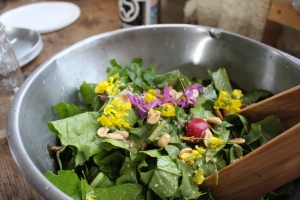
Nothing like fresh salad! Photo Credit: Makiko Yoshida
To us, self-sufficiency means providing most of our own food. In most cases, food sourced by your own hand is affordable, healthy, and more delicious. Once you have tasted fresh lettuce out of the garden or a perfectly ripe strawberry, any other will pale in comparison. You are serving up great rewards when you eat a meal composed solely of ingredients you harvested from your garden.
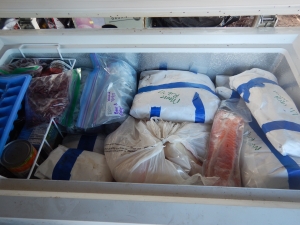
A full freezer. Not aesthetically pleasing, but a very happy sight! Photo Credit: Margaret Stern
Meat:
What kind of Meat:
Our meat consists primarily of wild game. In our surrounding hills, caribou, Dall sheep, and Moose are common wildlife. Alaskan hunting regulations are extremely strict. Most hunting occurs in the fall months. Our game management unit (GMU) also includes some winter hunts. These are great if we have not harvested enough meat in the fall seasons. We make a point of harvest all parts of the animal, from the meat, the organs, and the hide. Caribou heart is a delicacy!

Winter food. Photo Credit: Makiko Yoshida
We occasionally trade for meat on the road system. Last year, we worked out a work trade with our close friends that have a farm. We butchered 1/2 of a 400 lb pig. This gave us lard, pork chops, bacon, and sausage.

Pork! Photo Credit: Margaret Stern
How is it preserved:
We cure, dry, or freeze meat. Two years ago we flew in a freezer that we can run off of our solar panels. That makes keeping meat much easier. We don’t do much meat canning, though that is something we hope to pursue in the future. We also render all fat off of animals into lard that we can later use for cooking, baking, or sausage making.
Vegetables
What are they: 90% of our vegetables come from the garden or wild from the surrounding landscape.
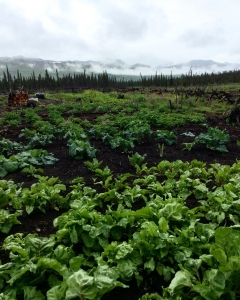
Late July Morning. Photo, Margaret Stern
During the summer months, we grow a 6,000 square foot garden. We grow a majority of root vegetables as well as greens and fruits. This garden provides us with enough food to subsist through the winter. We grow an excess that we sell to hunting lodges and, on occasion, a farmer’s market on the road system.
We also collect many wild greens and berries.
At the beginning of the winter we purchase a few 10lb sacks of onions from Costco for the season.
How are they preserved:
Root vegetables. Beets, Turnips, Fodder Beets, Carrots. Packed in sawdust and placed in the root cellar
Cabbages and Kohl Rabi: Placed in sacks and placed in the root cellar.

Cabbages for the root cellar.
Photo credit: Caity Potter
Potatoes: Hung in bags in the root cellar
Lettuces: Dug, placed in buckets, brought inside
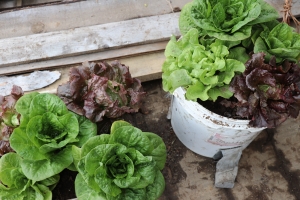
Lettuce to come inside. Photo credit: Caity Potter
Garlic, Shallots, and Onions: hung and dried inside.
Herbs and teas: dried
Hardy greens: blanched and frozen

Turnip greens, blanched and frozen.
Photo Credit: Makiko Yoshida
Peppers, eggplant, tomatoes: Pots brought inside before frost and eaten fresh.
Cabbages: Fermented into kraut and kimchi
Root vegetables: lacto-fermented
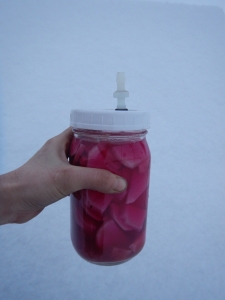
Lacto fermented turnips. Photo Credit: Margaret Stern
Wild greens: Sun-dried
Berries: Frozen or made into jam

Blueberries. Yum!
Photo Credit: Elizabeth Selktas
Dairy:
We are unable to produce many of our own dairy products at the homestead. We have Icelandic chickens that provide us with eggs during the fall, spring and summer. In the winter, they slow down quite a bit. We bring in a case of eggs from Costco and keep it in the root cellar. We import cheese and butter in bulk from Costco. We keep a store of powdered milk, too.
What is not sourced from the homestead?
Flour, Rice, Beans, Chocolate, Coffee, Spices, Nut butter, Nuts, Pasta, Dried Fruit, Black tea. These come from Costco. We are always on the hunt for a value. In Alaska, Costco has the best deals around.
What are typical Homestead Meals?

Fall Breakfast: Eggs with greens, pancakes, coffee, and homemade cranberry juice. Photo Credit: Caity Potter
In the wintertime, here are some typical meals.
Breakfast: Steel cut oats with blueberry jam, Homegrown potatoes with Chicken eggs, Sourdough pancakes with jam, Sourdough toats
Lunch: Caribou sandwich, broth and bread, leftover breakfast (we aren’t big lunch eaters)
Dinner: Moose Chili, Caribou curry, Wild Game Stew, Turnip Soup, Beet soup, Veggie stir fry, Moose-ghetti. Often times with sourdough Bread.
Products we Recommend for Preserving the Harvest:
Everything we recommend you can find in our home. Click on the photos to find a link for purchase.
Root Cellaring: Most of our crops go into the root cellar. This book on root cellaring educated us so that we could build our own root cellar. We recommend it to anyone wanting to take on their own crop storage project.
Lacto fermentation is one of my favorite ways to preserve food on the homestead. This is a very particular art. If you have never facto-fermented before, I recommend Sandor Katz’s Wild Fermentation. This book provides a great understanding for the process of fermentation and the science behind it.
For large batches of Sauerkrauts, Kimchi, and Pickles, we use large German-style Crocks. We have 3 or 4 of these Crocks filled in our root cellar and highly recommend them.
For smaller Lacto-Fermentation projects, we like to use these air-lock lids for wide mouth Ball jars. They are incredibly useful if you want to try out new recipes or simply want smaller servings of a fermented product. I use them for my favorite turnip pickles!
For making jams and jellies, we try to use as little sugar as possible. This is for health reasons, and because sugar is expensive and heavy! Because of this, we prefer Pomona’s Universal Pectin.
For powdered milk, we have a favorite brand of whole-fat powdered milk that we put in coffee, use for baking, and making. More fat is better for us in the cold weather, and it tastes infinitely more satisfying!
Hopefully this provides some ideas for your own homestead and some information on one of the questions we consistently receive… What do you eat??
Keep in touch as we will be offering a few events for the coming year related to this post.
- Homestead Gardening: Planning and Putting in the Garden
- ABC: Adventure with Blueberries and Caribou!
- Putting Food By: A lesson in food preservation
We will finalize dates before the New Year
Cheers, and happy harvests.
Margaret










Leave a Reply
Want to join the discussion?Feel free to contribute!